The Ultimate Guide to Beating Shopping Cart Abandonment

First, let’s determine what the actual cart abandonment rate is. According to an ongoing report by Barilliance—a study that’s monitored cart abandonment trends since 2016 and that is regularly updated by the authors—as of 2017, the actual cart abandonment rate was 78.65%.
What this means is that on a good day, just 22.35% of shoppers are closing the deal. Now factor this in with the average ecommerce conversion rate, which hovers between 2.35% and 11.45%, and you have the recipe for a lot of lost sales that could have been.
While these numbers may seem daunting, it’s important to first understand why shoppers abandon the cart. Knowing the main reasons why can help you make small changes to your online store that help you improve conversions, decrease abandonment and win back the business of undecided webroomers, who are always looking for the next best deal.
Here’s what you need to know.
Primary Shopping Cart Abandonment Reasons
As of 2017, cart abandonment rates resulted in online retailers losing an estimated $4 trillion in potential sales. Between 2014 and the end of 2018, shoppers added and abandoned nearly $21 trillion in unpurchased consumer goods from ecommerce websites. All told, mobile abandonment had the highest rate (81%), tablets came in second (71%) and desktop had the lowest rate (61%).
What’s causing consumers to change their minds about more than $20 trillion in potential sales over just four years?
“Four of the top five reasons users are bailing out of the checkout process stem from the logistics of entering information through desktop or mobile. Only one reason, the shipping costs, actually had to do with price,” explains Business Insider in a related report. “This shows that ecommerce retailers are coming up short with regard to the checkout process. Lengthy or complicated checkout forms, such as entering shipping addresses or payment information, account for approximately 39 percent of U.S. cart abandonments.”
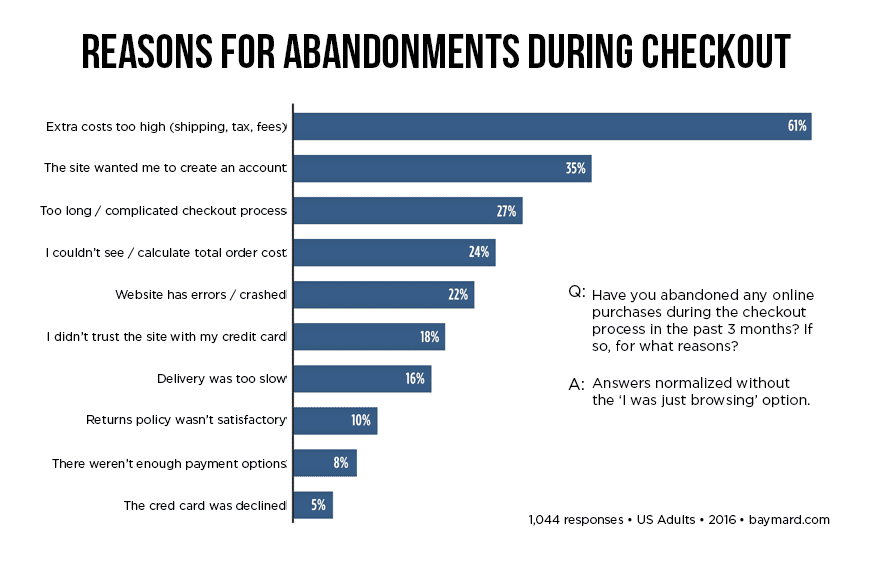
When factoring in reasons why shoppers don’t close the deal, you need to also consider these facts:
- 55% of shoppers abandon due to the cost of shipping.
- 35% of shoppers won’t close the deal without a security badge.
- 24% of the time, no shipping or added fees are disclosed, resulting in abandonment.
- Sites that take 3 seconds or longer to load have a 40% abandonment rate.
- 80% of shoppers want free shipping or they’ll abandon the cart.
- 66% of shoppers want an easy return policy or they won’t purchase.
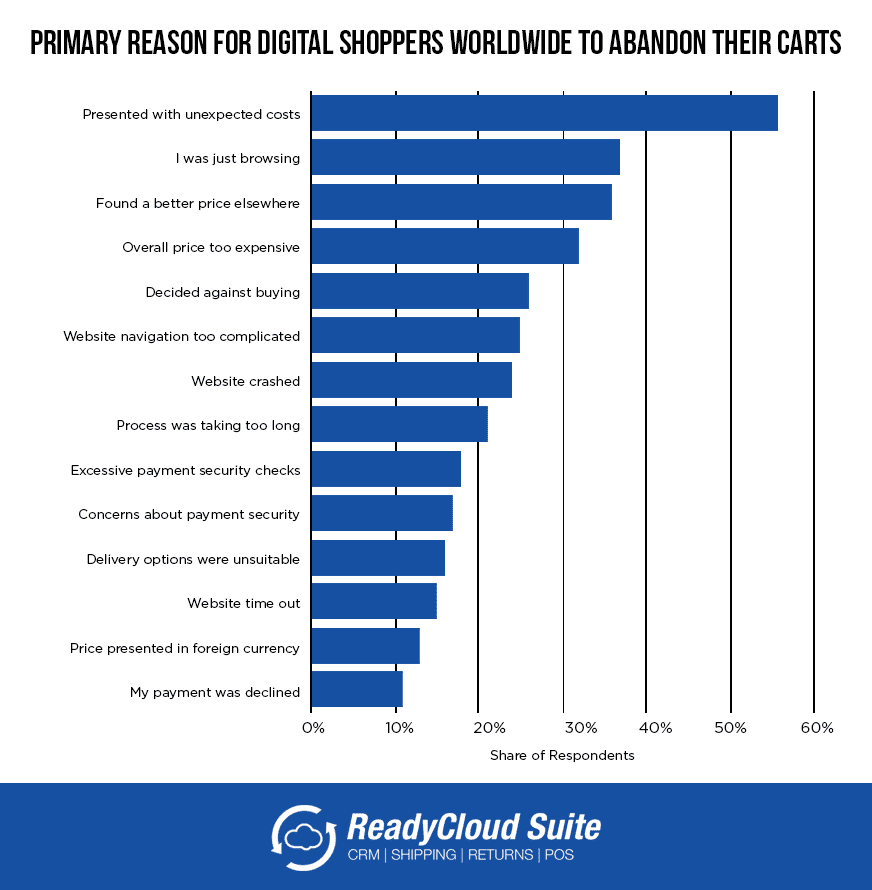
It’s also important to bear in mind that certain items have a higher abandonment rate than others. Leading the pack is apparel, which has a 40% cart abandonment rate (namely because people question the size, fit, style and how the product looks/feels when it arrives). Tech items come in second at a much lower rate of just 18%, with homeware products taking third place at 16%. See this chart below (via Statista) for even more clarity.
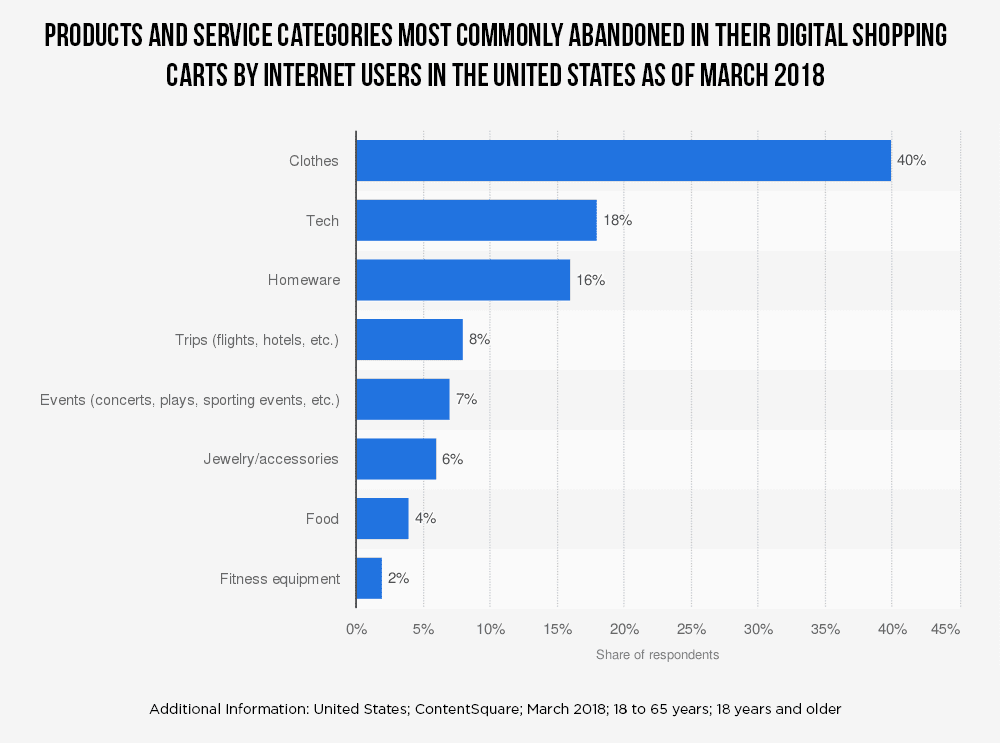
How to Decrease Cart Abandonment
Every forward-thinking online retailer wants more conversions and less abandonment. Understanding the steps that you can take to decrease cart abandonment will go a long way in you improving these numbers. Here are some tips to get you started.
State any added fees: Fees—such as shipping or returns fees and any taxes—should be stated clearly and made apparent in the shopping cart. A great example of this in motion can be found in the screenshot below of the Apple Store. Note how the cart displays the actual cost, including shipping (which is free in this case) and offers a “calculate tax” button so the consumer can easily assess any added fees and the true cost of the purchase.

Offer expedited shipping: Expedited shipping gives anxious shoppers the ability to pay a few dollars more to get their items sent faster. It’s so popular, in fact, that 25% of cart abandonment rates are directly linked to the lack of this key amenity being offered. What’s more, expedited shipping can be used to pad your profits by merely marking up the actual cost by a few dollars. It’s a featured that should be offered by every online retailer.
Allow shoppers to edit the cart: You’d be surprised at how many online stores there are with a static cart. It’s a big no-no in today’s shopping world, where mobile shoppers especially lament the inability to edit carts and update the volume of the purchase. In fact, stores lose an estimated 15% of potential sales each year due to the lack of this simple shopping cart feature.
Offer free shipping and easy returns: One of the most important things that you can do to decrease cart abandonment is to offer free shipping and hassle-free returns. In fact, studies on shopping cart abandonment rates have found that high shipping cost and hard returns can decrease your potential sales by 25%-50% simply due to cart abandonment rates.
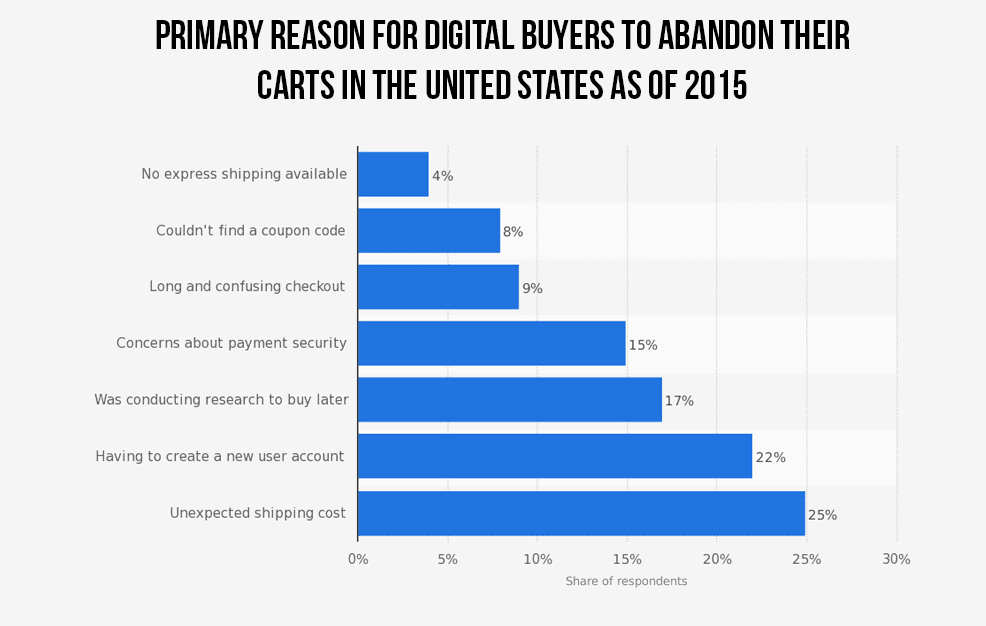
Send cart abandonment emails: Another proven method you can use to improve conversion rates is to send a cart abandonment email to the shopper. Recent studies have found that companies that send a cart abandonment email within 30 minutes of the shopper leaving result in a 66% open rate and as much as a 12% reconversion rate on an otherwise lost sale.
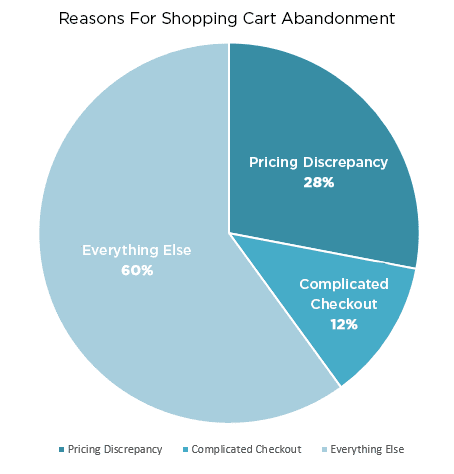
2019 Shopping Cart Abandonment Statistics
Now that you know all the reasons why shoppers leave a cart without making sale, here is a grand roundup of the most recent and pertinent 2019 ecommerce shopping cart abandonment statistics. Use the numbers to improve your conversion rates across the board.
- A long checkout causes a 27% cart abandonment rate.
- Cart abandonment rates hover at around 77%.
- High shipping cost results in up to a 66% abandonment rate.
- Almost $4 trillion is lost in potential sales due to abandonment annually.
- 75% of cart abandoners will return to the same site later.
- Cart abandonment rates peak between 8pm and 9pm.
- Hard to navigate sites results in 25% increased cart abandonment.
- 63% of consumers will abandon a cart if no product reviews are offered.
- Cart abandonment emails have a 40% open rate if sent within 3 hours.
- The payment stage results in an average abandonment rate of 41%.
- Lack of security badging results in an average 13% abandonment rate.
- Slow website speed can result in 64% of shoppers not completing the sale.
- Abandonment increases by 7% for each second of loading time.
- Discounts offered at checkout can decrease abandonment by 54%.
- 80% of consumers won’t buy if returns are hard.
- 61% of consumers abandon the cart over added fees (taxes, shipping, etc.)
- 37% of cart abandoners are not ready to buy and are just browsing.
- 36% of consumers abandon a cart due to finding a better deal elsewhere.
- 32% of consumers abandon the cart because of high prices.
Need Even More Stats?
Shopping cart abandonment is a fact of life for ecommerce merchants. That said, though, there are things you can do to decrease your bounce rates and keep people moving through your sales funnel.
Once you understand the facts about cart abandonment rates, you can take steps to address the most common customer concerns and navigate around them. This, in turn, allows you to boost your sales and keep your ecommerce store moving forward for years to come.
For even more stats on how you can reduce abandonment and increase sales, take a look at this infographic we’ve created below.

What You Should Do Now
Here are 3 ways ReadyReturns can help you deliver amazing return experiences that eliminate prepaid labels and boxes, delight customers, and protect your margins:
Schedule a Demo – See how ReadyReturns turns product returns into your competitive advantage with “Amazon-like” returns and cost-saving features.
Start Your Free Trial of ReadyReturns (No CC Required) – Set up in minutes. Instantly offer QR code returns, product exchanges, and custom return rules that turn frustrated customers into repeat buyers.
Try ReadyCloud at No Cost – Why manage shipping and returns separately? Get ReadyShipper X, ReadyReturns, and more in one unified platform for seamless fulfillment and order management.
Share On:









